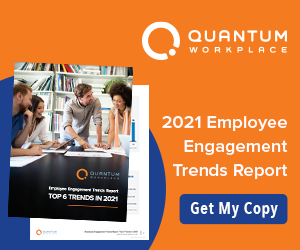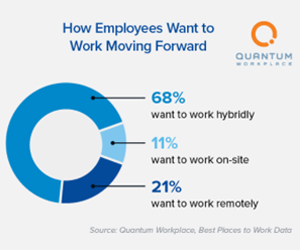The ever-changing work environment of 2021 has left leaders wondering what to prioritize as they navigate uncertain business conditions and adapt to evolving employee needs.
With this high rate of change, safeguarding the employee experience has been difficult. This disruption has prompted leaders to focus on what matters most to actively engage and retain their top talent.
With one of the largest employee engagement databases in the United States that spans across thousands of organizations in every industry, Quantum Workplace has a unique vantage point on the workplace and trends in the employee experience.
Understand the trends and how to best serve your employees in unparalleled times with the 6 employee engagement trends of 2021.
6 Trends Impacting Employee Engagement 
Snag the FULL 2021 Employee Engagement trends report ⇒
- Leaders Lack Transparency and Communication About Organizational Changes.
During the height of the pandemic leaders were communicating much more than usual and sharing more information than they ever had before. Now, many leaders have stopped continuous communication, and it hasn’t gone unnoticed to employees.
In April 2020 and again in January 2021, 78 percent of employees said they understand why their organization makes changes. However, by July of 2021, this figure dropped to 70 percent. This drop suggests possible employee-organization misalignment, as employees are left in the dark when changes are made.
Recommendation:
To increase alignment and engage your workforce, communicate about the changes your organization makes. By letting employees in on when and why certain measures are being taken, you can increase buy-in and understanding of the plans and decisions you make.
- Trust in Leadership Declines After the Height of the Pandemic.
These leadership metrics show that employees’ trust in leadership is trending downward.
At its peak, about 9 in 10 employees trusted their senior leaders to lead the company to future success during the height of the pandemic. That figure has since dropped to 84 percent in May of 2021.
Recommendation:
Design processes and channels that prioritize consistent communication to create a workplace environment built on trust. Trust in leadership is built with transparent and regular communication, a focus on engagement and retention, and a successful business strategy.
- Work-Life Balance Has Been Disrupted.
Employee flexibility is critical in driving employee engagement. During the pandemic, in the spring and summer months of 2020, an average of almost 87 percent of employees said their job gives them the flexibility to meet the needs of both their work and personal lives.
 In Q1 of 2021, 86 percent of employees agreed with this statement, but by Q2, this dropped to only 81 percent.
In Q1 of 2021, 86 percent of employees agreed with this statement, but by Q2, this dropped to only 81 percent.
When employees feel that flexibility, manageable workloads, clear expectations, and collaborative goals are lacking, workplace stress becomes a threat to the employee experience. This causes burnout and low engagement levels.
Recommendation:
To retain employees, consider re-evaluating your employee work-life balance initiatives. Many employees want to continue working remotely. To retain top talent, create a policy that prioritizes both employee flexibility and business success. Best Places To Work companies emphasize gather feedback through employee engagement programs to inform leadership and decision making.
- Organizations Lack Employee Health and Wellbeing Support.
To effectively engage employees, organizations need to create a culture that prioritizes their needs—this includes safeguarding employees’ mental and physical health and wellbeing.
In April through August of 2020, an average of 87 percent of employees said their culture supports their health and wellbeing. In Q1 of 2021, 86 percent of employees agreed, declining to only 82 percent in Q2.
When organizations lack a strong culture that promotes employee wellbeing, it’s highly visible in the employee experience. When employees don’t feel cared for, their engagement declines.
Recommendation:
Focus your programs around employee health and wellbeing to attract and retain top talent to your organizations and push their performance as employees.
- Employee Recognition is Trending Downward.
When employees are regularly recognized by others, they feel empowered to perform at their best. When employees don’t feel recognized, employee engagement and performance decline.
At the peak of the pandemic, 81 percent of employees said they know they would be recognized if they contribute to the organization’s success. However, this sentiment dropped to 72 percent by May of 2021.
Lack of recognition negatively affects employees’ confidence to perform successfully. Employees need to feel appreciated and heard by others to continuously produce positive outcomes. Helping employees feel valued has been a standard driver of engagement for years.
Recommendation:
Aim to create a culture that celebrates recognition, especially in times of low employee engagement.
- Career Growth Opportunities Have Become Less Clear.
Offering opportunities for career growth and development is essential in retaining high performers.
At the beginning of 2021, 78 percent of employees reported they saw professional growth and career development opportunities for themselves in their organization. This has since declined with about 72 percent seeing these opportunities in May 2021.
Without the opportunity for growth, employees can feel stagnant and unwilling to perform more than the bare minimum. Employees may search for other employers in this situation, negatively affecting retention rates. Leverage modern HR tech solutions, like Quantum Workplace performance management software to understand employees’ growth and development interests.
Once this understanding is in place, you can close internal skill gaps with online training sessions and webinars, manager coaching and mentorship, peer coaching, cross-training, and stretch assignments. When organizations invest in their employees, their skills, engagement, and retention rates grow.
5 HR Focus Areas For Future Success
- Employer Brand
- Learning & Development
- Flexibility & Well-being
- Employee Feedback
- Predictive Analytics
Get the FULL report to uncover more key insights
Conclusion
The lasting effects of the pandemic have created a changeable work environment, unparalleled to recent times. The unique chain of events that workplaces experienced over the past 18 months prompted an understanding behind the importance of employee engagement. Learn how Quantum Workplace Employee Success Platform can help your company navigate the ever-changing modern workplace.